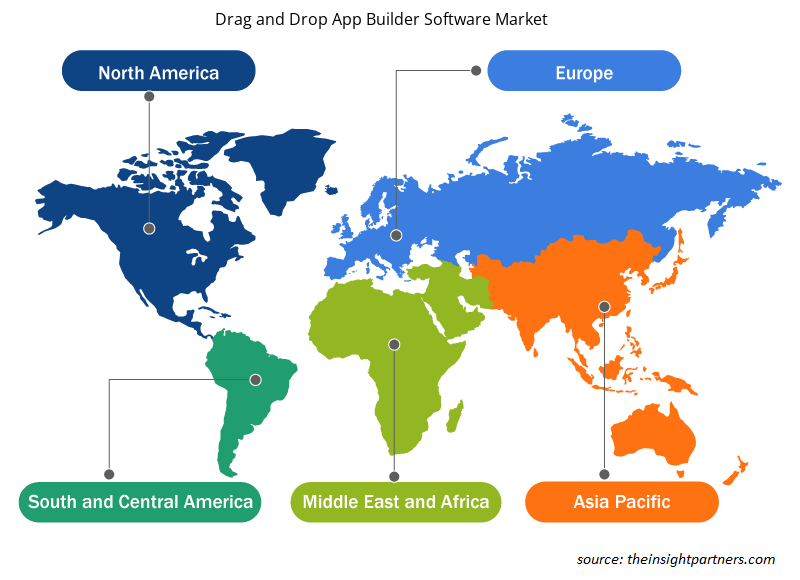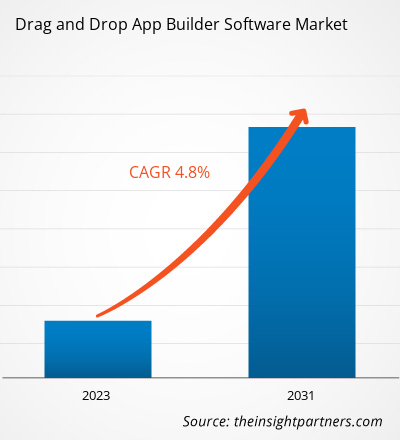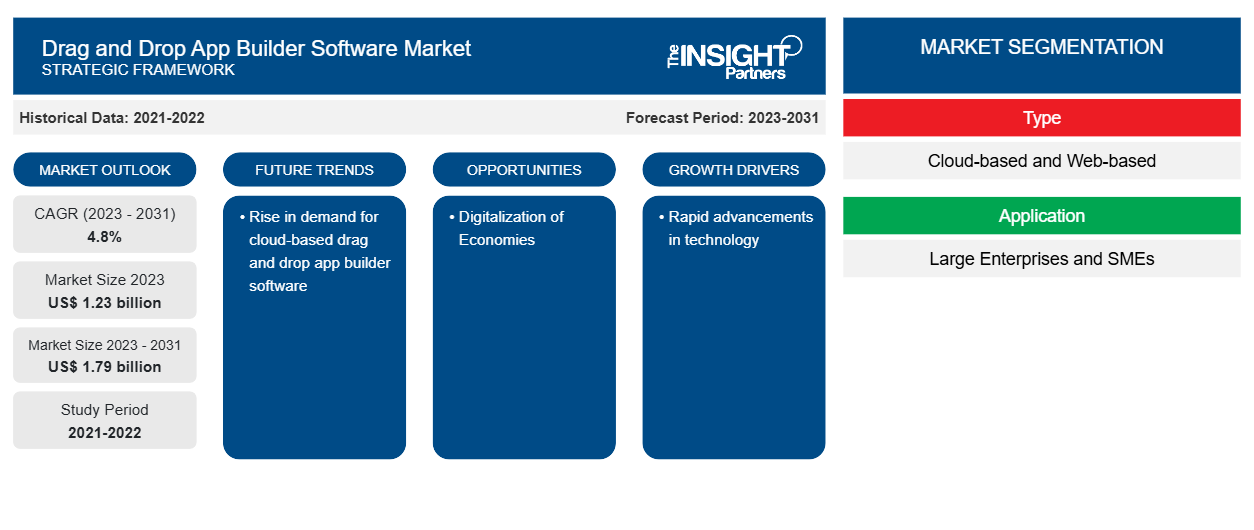Der Markt für Drag-and-Drop-App-Builder-Software soll von 1,23 Milliarden US-Dollar im Jahr 2023 auf 1,79 Milliarden US-Dollar im Jahr 2031 wachsen; von 2023 bis 2031 wird eine durchschnittliche jährliche Wachstumsrate von 4,8 % erwartet. Die steigende Nachfrage nach cloudbasierter Drag-and-Drop-App-Builder-Software dürfte ein wichtiger Markttrend für Drag-and-Drop-App-Builder-Software bleiben.
Marktanalyse für Drag & Drop-App-Builder-Software
Die schnellen technologischen Fortschritte, beispielsweise im Bereich Cloud Computing und Entwicklung mobiler Apps, haben zum Wachstum des Marktes für Drag-and-Drop-App-Builder-Software beigetragen.
Marktübersicht für Drag & Drop-App-Builder-Software
Drag-and-Drop-App-Builder-Software ist ein revolutionäres Tool, mit dem Unternehmen individuelle mobile Anwendungen erstellen können, ohne dass komplexe Programmierkenntnisse oder technisches Fachwissen erforderlich sind. Mit dieser intuitiven Software können selbst Personen mit begrenzten technischen Kenntnissen funktionsreiche Apps entwerfen und entwickeln, die ihren spezifischen Geschäftsanforderungen gerecht werden. Darüber hinaus bietet diese Software eine breite Palette vorgefertigter Vorlagen und Module, die leicht angepasst werden können, um das Branding und die individuellen Anforderungen eines Unternehmens widerzuspiegeln. Unternehmen können ihre Logos, Farben und Schriftarten hinzufügen, um eine einheitliche und professionelle App zu erstellen, die mit ihrer Markenidentität übereinstimmt.
Passen Sie diesen Bericht Ihren Anforderungen an
Sie erhalten kostenlos individuelle Anpassungen an jedem Bericht, einschließlich Teilen dieses Berichts oder einer Analyse auf Länderebene, eines Excel-Datenpakets sowie tolle Angebote und Rabatte für Start-ups und Universitäten.
-
Holen Sie sich die wichtigsten Markttrends aus diesem Bericht.Dieses KOSTENLOSE Beispiel umfasst eine Datenanalyse von Markttrends bis hin zu Schätzungen und Prognosen.
Treiber und Chancen auf dem Markt für Drag & Drop-App-Builder-Software
Schnelle technologische Fortschritte begünstigen den Markt
Technologische Fortschritte wie Cloud Computing und die Entwicklung mobiler Apps haben eine bedeutende Rolle beim Wachstum des Marktes für Drag-and-Drop-App-Builder-Software gespielt. Diese Fortschritte haben die Branche der Entwicklung mobiler Apps revolutioniert und Unternehmen und Entwicklern neue Möglichkeiten eröffnet, umfassende und immersive mobile Erlebnisse zu schaffen. Zusammenfassend lässt sich sagen, dass die rasanten technologischen Fortschritte, darunter Cloud Computing und die Einführung von Low-Code- und No-Code-Entwicklungsplattformen, zum Wachstum des Marktes für Drag-and-Drop-App-Builder-Software beigetragen haben. Diese Fortschritte haben die Branche der Entwicklung mobiler Apps revolutioniert und es Unternehmen und Entwicklern zugänglicher und effizienter gemacht, innovative und immersive mobile Erlebnisse zu schaffen.
Digitalisierung der Volkswirtschaften of Economies
Die Digitalisierung der Wirtschaft hat zu einer erhöhten Nachfrage nach benutzerfreundlichen App-Entwicklungstools geführt, was zum Wachstum des Marktes für Drag-and-Drop-App-Builder-Software beigetragen hat. Diese Plattformen ermöglichen es Entwicklern, benutzerdefinierte Apps ohne umfangreiche Codierungsanforderungen oder mit minimaler manueller Codierung zu erstellen, wodurch sie die Entwicklung qualitativ hochwertiger Produkte beschleunigen können. Dies steht im Gegensatz zum herkömmlichen Softwareentwicklungslebenszyklus (SDLC), der in der Regel mehr Zeit und Aufwand erfordert. Das schnelle Tempo der digitalen Transformation hat Unternehmen dazu veranlasst, die Bedürfnisse der Verbraucher schnell zu erfüllen, und Drag-and-Drop-App-Builder haben sich als Lösung herausgestellt, um diesen Prozess zu erleichtern.digitalization of economies has led to an increased demand for user-friendly app development tools, which has contributed to the growth of the drag and drop app builder software market. These platforms allow developers to create customized apps without extensive coding requirements or with minimal hand-coding, enabling them to accelerate the development of high-quality products. This is in contrast to the conventional software development life cycle (SDLC) that typically involves more time and effort. The rapid pace of digital transformation has driven companies to meet consumer needs quickly, and drag and drop app builders have emerged as a solution to facilitate this process.
Segmentierungsanalyse des Marktberichts zur Drag-and-Drop-App-Builder-Software
Wichtige Segmente, die zur Ableitung der Marktanalyse für Drag & Drop App Builder-Software beigetragen haben, sind Typ und Anwendung.
- Nach Typ wird der Markt in Cloud -basiert und Web-basiert unterteilt. Das Cloud-basierte Segment hatte 2023 einen größeren Marktanteil.
- In Bezug auf die Anwendung ist der Markt in Großunternehmen und KMU unterteilt. Das Segment der Großunternehmen hatte im Jahr 2023 einen größeren Marktanteil.
Marktanteilsanalyse für Drag & Drop App Builder-Software nach geografischer Lage
Der geografische Umfang des Marktberichts für Drag-and-Drop-App-Builder-Software ist hauptsächlich in fünf Regionen unterteilt: Nordamerika, Asien-Pazifik, Europa, Naher Osten und Afrika sowie Südamerika/Süd- und Mittelamerika. Nordamerika dominierte den Markt für Drag-and-Drop-App-Builder-Software im Jahr 2023. Die Vereinigten Staaten und Kanada haben stark in Forschungs- und Entwicklungsaktivitäten investiert, was zur Entwicklung fortschrittlicher und innovativer Technologien auf dem Markt für Drag-and-Drop-App-Builder-Software führte. Darüber hinaus wird erwartet, dass kleine und mittlere Unternehmen (KMU), die im IT-Sektor in Nordamerika tätig sind, den Markt aufgrund der zunehmenden Erschwinglichkeit von Cloud-basierten Lösungen antreiben werden.
Regionale Einblicke in den Markt für Drag & Drop-App-Builder-Software
Die regionalen Trends und Faktoren, die den Markt für Drag-and-Drop-App-Builder-Software während des gesamten Prognosezeitraums beeinflussen, wurden von den Analysten von Insight Partners ausführlich erläutert. In diesem Abschnitt werden auch die Marktsegmente und die Geografie von Drag-and-Drop-App-Builder-Software in Nordamerika, Europa, im asiatisch-pazifischen Raum, im Nahen Osten und Afrika sowie in Süd- und Mittelamerika erörtert.

- Erhalten Sie regionale Daten zum Markt für Drag & Drop-App-Builder-Software
Umfang des Marktberichts zur Drag & Drop-App-Builder-Software
| Berichtsattribut | Details |
|---|---|
| Marktgröße im Jahr 2023 | 1,23 Milliarden US-Dollar |
| Marktgröße bis 2031 | 1,79 Milliarden US-Dollar |
| Globale CAGR (2023 - 2031) | 4,8 % |
| Historische Daten | 2021-2022 |
| Prognosezeitraum | 2023–2031 |
| Abgedeckte Segmente |
Nach Typ
|
| Abgedeckte Regionen und Länder |
Nordamerika
|
| Marktführer und wichtige Unternehmensprofile |
|
Marktteilnehmerdichte: Der Einfluss auf die Geschäftsdynamik
Der Markt für Drag-and-Drop-App-Builder-Software wächst rasant. Dies wird durch die steigende Nachfrage der Endnutzer aufgrund von Faktoren wie sich entwickelnden Verbraucherpräferenzen, technologischen Fortschritten und einem größeren Bewusstsein für die Vorteile des Produkts vorangetrieben. Mit der steigenden Nachfrage erweitern Unternehmen ihr Angebot, entwickeln Innovationen, um die Bedürfnisse der Verbraucher zu erfüllen, und nutzen neue Trends, was das Marktwachstum weiter ankurbelt.
Die Marktteilnehmerdichte bezieht sich auf die Verteilung der Firmen oder Unternehmen, die in einem bestimmten Markt oder einer bestimmten Branche tätig sind. Sie gibt an, wie viele Wettbewerber (Marktteilnehmer) in einem bestimmten Marktraum im Verhältnis zu seiner Größe oder seinem gesamten Marktwert präsent sind.
Die wichtigsten Unternehmen auf dem Markt für Drag & Drop App Builder-Software sind:
- DronaHQ
- Salesforce
- Thunkable Inc.
- WaveMaker Inc.
- Zoho Corporation
- Mobirise
Haftungsausschluss : Die oben aufgeführten Unternehmen sind nicht in einer bestimmten Reihenfolge aufgeführt.

- Überblick über die wichtigsten Akteure auf dem Markt für Drag & Drop-App-Builder-Software
Neuigkeiten und aktuelle Entwicklungen zum Drag & Drop App Builder-Softwaremarkt
Der Markt für Drag-and-Drop-App-Builder-Software wird durch die Erfassung qualitativer und quantitativer Daten nach Primär- und Sekundärforschung bewertet, die wichtige Unternehmensveröffentlichungen, Verbandsdaten und Datenbanken umfasst. Im Folgenden finden Sie eine Liste der Entwicklungen auf dem Markt:
- Im Dezember 2020 erhielt Quixy, eine führende Plattform für No-Code-Anwendungsentwicklung und Geschäftsprozessmanagement (BPM), die angesehene Anerkennung und wurde von G2, einer renommierten Branchenautorität, als „Leader“ in der Kategorie „No-Code-Anwendungsentwicklung“ bezeichnet.
(Quelle: Quixy, Pressemitteilung, 2020)
- Im September 2020 organisierte DronaHQ einen No-Code-Hackathon mit dem Ziel, BWL-Studenten einzubeziehen und die Eigenschaften der Bürgerentwicklung und eine problemlösende Denkweise zu fördern. Der Hackathon bot den Studenten die Möglichkeit, App-Entwicklung zu erlernen, ohne dass sie über umfassende Programmierkenntnisse verfügen mussten.
(Quelle: DronaHQ, Pressemitteilung, 2020)
Marktbericht zur Drag & Drop App Builder-Software – Abdeckung und Ergebnisse
Der Bericht „Marktgröße und Prognose für Drag & Drop-App-Builder-Software (2021–2031)“ bietet eine detaillierte Analyse des Marktes, die die folgenden Bereiche abdeckt:
- Marktgröße und Prognose auf globaler, regionaler und Länderebene für alle wichtigen Marktsegmente, die im Rahmen des Projekts abgedeckt sind
- Marktdynamik wie Treiber, Beschränkungen und wichtige Chancen
- Wichtige Zukunftstrends
- Detaillierte PEST/Porters Five Forces- und SWOT-Analyse
- Globale und regionale Marktanalyse mit wichtigen Markttrends, wichtigen Akteuren, Vorschriften und aktuellen Marktentwicklungen
- Branchenlandschaft und Wettbewerbsanalyse, einschließlich Marktkonzentration, Heatmap-Analyse, prominenten Akteuren und aktuellen Entwicklungen
- Detaillierte Firmenprofile
- Historische Analyse (2 Jahre), Basisjahr, Prognose (7 Jahre) mit CAGR
- PEST- und SWOT-Analyse
- Marktgröße Wert/Volumen – Global, Regional, Land
- Branchen- und Wettbewerbslandschaft
- Excel-Datensatz
Aktuelle Berichte
Verwandte Berichte
Erfahrungsberichte
Grund zum Kauf
- Fundierte Entscheidungsfindung
- Marktdynamik verstehen
- Wettbewerbsanalyse
- Kundeneinblicke
- Marktprognosen
- Risikominimierung
- Strategische Planung
- Investitionsbegründung
- Identifizierung neuer Märkte
- Verbesserung von Marketingstrategien
- Steigerung der Betriebseffizienz
- Anpassung an regulatorische Trends























 Kostenlose Probe anfordern für - Markt für Drag-and-Drop-App-Builder-Software
Kostenlose Probe anfordern für - Markt für Drag-and-Drop-App-Builder-Software